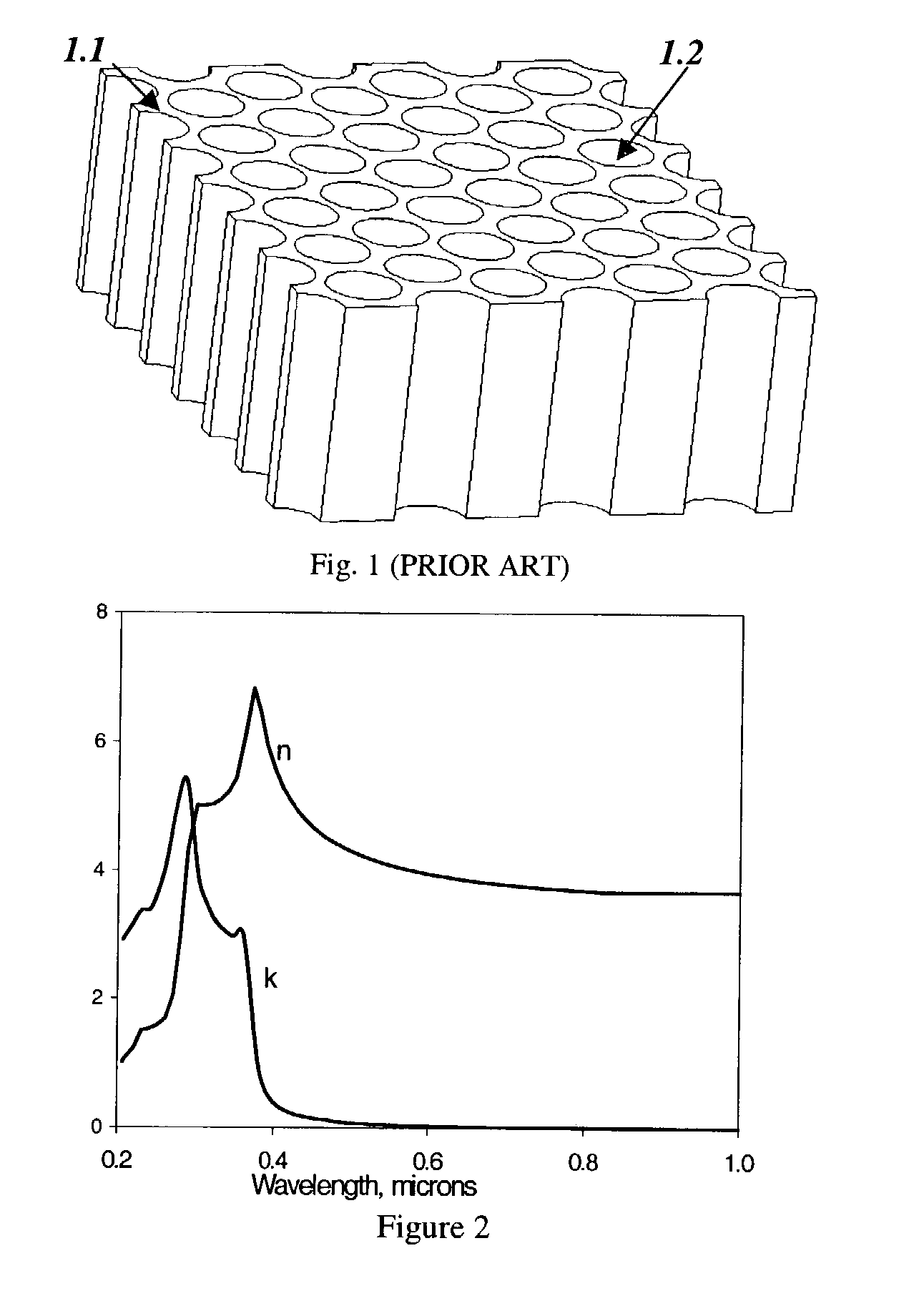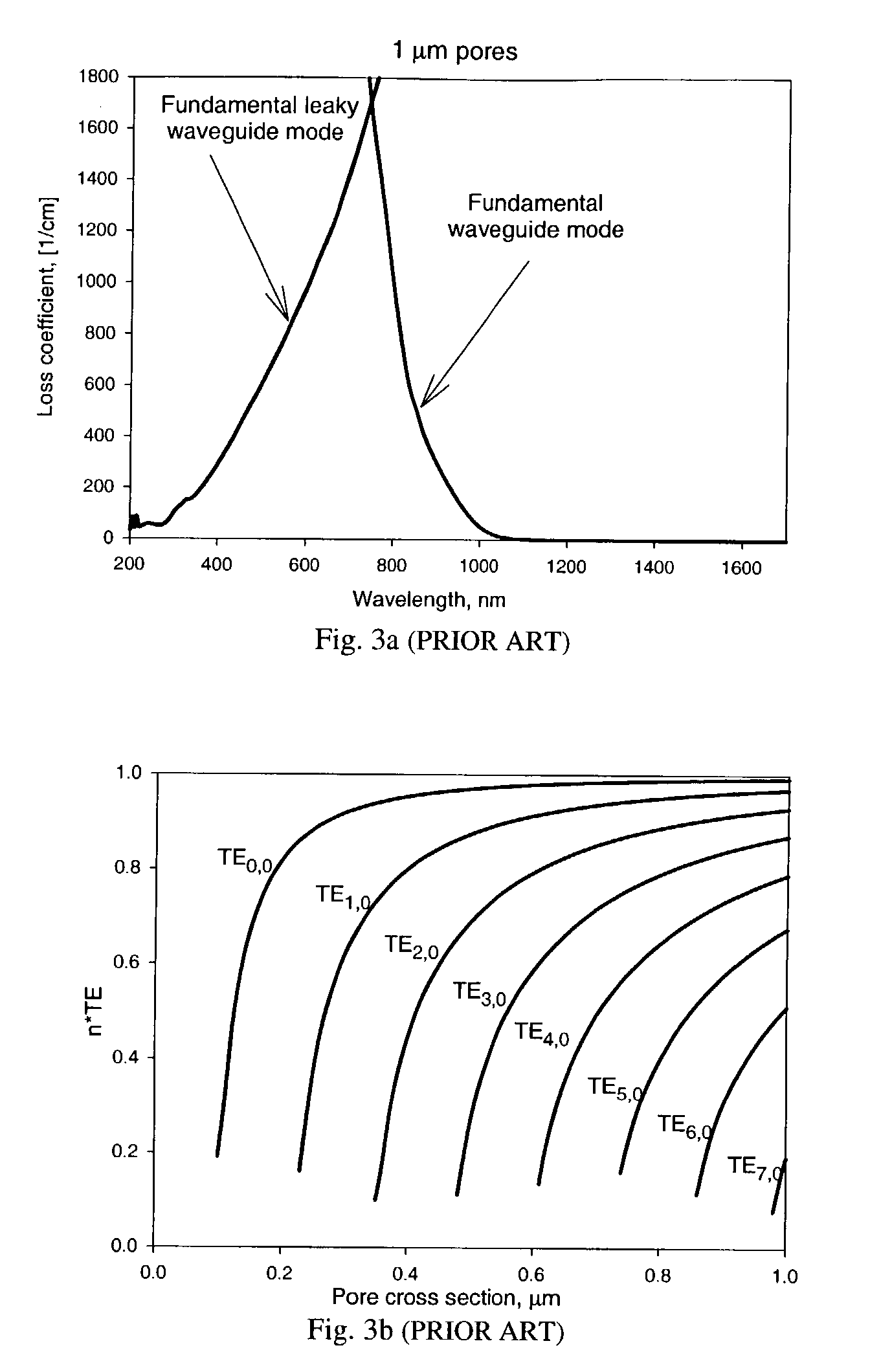Method of manufacturing a spectral filter for green and shorter wavelengths
a manufacturing method and technology for spectral filters, applied in the field of optical filters, can solve the problems of poor optical performance, limited physical longevity, and disadvantages of prior art optical filters and/or coating constructions, and achieve the effects of reducing manufacturing complexity, and improving the quality of spectral filters
- Summary
- Abstract
- Description
- Claims
- Application Information
AI Technical Summary
Benefits of technology
Problems solved by technology
Method used
Image
Examples
example 2
[0162] The method in Example 1 was repeated but improved by increasing the smoothness of the pore walls (reducing the optical scattering). To suppress the roughness, the SiO.sub.2 layer was etched off the pore walls in HF (5 minutes in 48% aqueous solution under agitation). The wafer was then cleaned in de-ionized water for 5 minutes and was placed into the hot tube furnace (1000.degree. C.) for 2 hours a second time to re-form a layer of silicon dioxide on the pore walls. A functional short-pass filter consisting of a free-standing MPSi layer with about 120 nm of SiO.sub.2 covering the smoothed pore walls was thus formed.
example 3
[0163] In a third example, a p-doped double-side polished (100) higher-resistivity Si wafer, a different electrolyte and a long-wavelength suppression layer applied to the second surface of the MPSi layer were used. The resistivity was in the 67.9-73 Ohm*cm range as measured by the vendor. The wafer was oxidized in the hot tube (1000.degree. C.) for 4 hours, producing 200 nm of oxide on all surfaces of the silicon. The wafer was photolithographically patterned from the first side of the wafer (i.e. holes in a photoresist layer were formed at the predetermined locations). The pattern was of cubic symmetry with round holes spaced 5 microns apart and having diameters of 2.5 microns. In this example, the axes of the pattern were oriented parallel to the crystallographic axes of the silicon wafer. The photoresist pattern was transferred into the SiO.sub.2 layer through a reactive ion etching process. The subsequent etch pit formation and anodization steps were the same as in Example 1, e...
example 4
[0164] In this example, the steps of Example 1 were followed except a lower resistivity wafer and a different electrolyte composition were used and mechanical removal of the unwanted silicon in the pore array area was employed. The resistivity was in the 20-40 Ohm*cm range as measured by the vendor. The electrolyte had the composition 1[HF]+2 [Ethanol]+12 [DMF] by volume. After the pores were etched and the gold removed, the wafer was mechanically polished from the back side until the porous layer was reached. During this process, the wafer was waxed by its first surface to a glass 2.times.2 inch wafer to provide mechanical support for the MPSi layer during the polishing step. After the unwanted silicon was removed, the wafer was then placed into acetone for 6 hours to strip it from the glass plate. The wafer was cleaned in multiple fresh rinses of acetone to completely remove remaining wax. The oxidation step was then performed, providing a functional short-pass filter consisting o...
PUM
| Property | Measurement | Unit |
|---|---|---|
| thickness | aaaaa | aaaaa |
| thickness | aaaaa | aaaaa |
| temperature | aaaaa | aaaaa |
Abstract
Description
Claims
Application Information
 Login to View More
Login to View More - R&D
- Intellectual Property
- Life Sciences
- Materials
- Tech Scout
- Unparalleled Data Quality
- Higher Quality Content
- 60% Fewer Hallucinations
Browse by: Latest US Patents, China's latest patents, Technical Efficacy Thesaurus, Application Domain, Technology Topic, Popular Technical Reports.
© 2025 PatSnap. All rights reserved.Legal|Privacy policy|Modern Slavery Act Transparency Statement|Sitemap|About US| Contact US: help@patsnap.com



